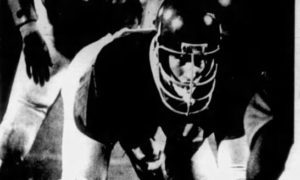Editor note: Dave Petruska is a former Tucson Citizen sportswriter and assistant sports editor who graces his presence on AllSportsTucson.com from time to time.
By Dave Petruska
I dribble a basketball as part of my exercise routine, usually in my garage, sometimes over at the gym if I have the time. I dribbled once on the walk to get my mail, but the sound from it, Tucson Citizen columnist Corky Simpson always described basketball as “thump, thump,” was too loud for my neighbors, echoed throughout the neighborhood because my small subdivision is in a valley surrounded on the east side and north side by hills. I use industrial style ear protection when I’m dribbling in the garage because it gets loud, even with the door open.

Dave Petruska
So the other day I’ve got the garage doors open and I’m doing crossovers, which are a lot harder for me to do now that I have to wear compression gloves to protect my fingers when I’m doing any kind of exercise, and the ball gets away from me and rolls down the driveway, and, of course, goes right between the space between my garbage and recycling cans and into the street.
One of the neighborhood kids grabs the ball and throws a bounce pass back to me right between the space between the cans, and that pass, because it kind of curved a bit, reminded me of a fun story that I wrote last century, which has more gravitas than “I probably wrote about this in the 1983-1984 college basketball season,” and the response to that story. I wish I could share the actual print story, but it ran years before the Citizen’s online archives and I don’t have a copy of it.
Tom Davis, the basketball coach, was big on the use of the bounce pass. So was John Hydrusko, my St. Mary’s Grammar School coach in South River, N.J., and I think the genesis of that story came from watching Davis’ teams, Coach Hydrusko’s rules about bounce passes that always stuck with me (The Associated Press rule says to use the last name of person after the first identification, but it sounds too weird to me to not call him Coach Hydrusko), and a passing comment by Stanford athlete John Paye after a Stanford-Arizona football game.
I don’t know what specific rules Davis, who was coaching Stanford University at the time of the story, had about bounce passes, but they seemed pretty loose from my observations. On the other hand Coach Hydrusko had very specific rules. He wanted the bounce pass to be no lower than the knees and no higher than the shoulders. He preferred the pass to be thrown using two hands because he felt those were more controlled, but he was OK with one hand as long as long as it was not off the dribble. Any pass that was too low was greeted with the following: “Jesus, Mary and Joseph! Go ahead, hit him in the ankles!!” I didn’t play that much, but I drew three “JMJs” from Coach Hydrusko on one sequence where I threw a one-handed pass off the dribble that hit a wide-open Dave Pawlowski in the ankles.
And the only reason I remember this is, well, because I didn’t really play that often, and I made up for the bad play with a steal and a fast-break opportunity with Dave (and we break the rule again because it seems strange for me to use Pawlowski for Dave) for a basket that Coach Hydrusko talked with me about after the game. Instead of me attacking with the dribble, Dave and I did a series of quick bounce passes to each other that got the lone defender so turned around that he tripped and fell to the court. I told Coach Hydrusko that I did it that way because the defender was good at drawing charges, that I passed up the scoring opportunity because Dave was on the left side of the court and that all the members of the team needed work on our left-handed layups, that I had owed him that one because I screwed up the earlier chance, and, because the defender had fallen down, I would be in position for a rebound if Dave missed. Coach Hydrusko absorbed this for a few moments, grasping, I guess, that an eighth-grader who rarely played had made these quick decisions, and then put his hands on my shoulders and said something I would hear for most of my basketball life: “Davey, I wish you were taller.” I wasn’t happy about that, but I couldn’t argue with that since I was 4 feet 8 at that time, nowhere near the majestic height of 5 feet 7 that I reached in my first year of college.
And so were off that detour, which brings us back to Paye, who was a two-sport athlete at Stanford, playing football and basketball. In 1983 he was the starting QB for Stanford. The Cardinal only won one game that year, an upset win over Arizona, in which Paye had a big game. After the game, several of the UA beat writers gathered to talk with a UA defensive back, I think it was Greg Turner, who said, something like, “So, you only want to talk with me after I get beat.” And that comment did adjust my thinking about covering college football, but we’ll get back to that later.
I was talking to Paye after that Stanford win and he mentioned that he would soon be throwing completely different kinds of passes playing basketball, and that thought stuck with me. I was not the beat writer for basketball, so I wasn’t doing game stories. I would do some type of feature story off the game, and I convinced the sports editor on the idea of counting how many bounce passes Stanford used during the game and to describe the different types they used.
This was a Thursday game and the story appeared Friday. Arizona was playing California on Saturday and I’m on press row getting ready for the game and a couple of UA fans sitting behind me at McKale Center, were talking about how much they liked my story, although they don’t mention my name, which happens all the time if you are not a columnist. These weren’t the folks who normally sat behind me at games, just a couple of guys who moved down temporarily during the team warm-up drills. And I have to digress a bit here, and if you’ve gotten to this point in the story you are going to hang around for the finish, to talk about the newspaper structure in Tucson for those who don’t know about it. The Citizen was the afternoon paper owned by Gannett, the Arizona Daily Star the morning paper owned by Pulitzer at that time. Totally different writing and editing and design teams and photographers, totally different owners, but the papers shared ad and production teams through a third entity, Tucson Newspapers Incorporated, TNI for short. Despite our management’s insistence, many people thought the Star and the Citizen were one and the same because of the TNI connection. Heck, if you called the main number, the operator would respond with “Star Citizen.”
So one of the guys mentions how funny that Star story was, and I turned my head and told him it was in the Citizen. He says no, he only gets the Star, so he saw it in the Star. And I completely turn around and say I wrote it, showed him my press credential and said I worked for the Citizen. I happened to have a copy of Friday’s Citizen in my briefcase, so I grabbed it and showed them that it appeared in the Citizen, and despite all this, the guy says, “well, you guys are the same paper.” Before I could respond to that an usher came down and told them they had to leave. Years later, when the Citizen was shut down, I had people who I had known for a long time say, “well, now you’ll work for the Star” and it would be an awkward “doh” moment for me.
And I would have ended the story with the previous sentence, but I did promise up high that I would talk briefly about what the UA defensive back had mentioned about only talking to the DBs after they get beat. I looked back on some of my stories for that year and he was right. I did tend to write about the DBs only when they messed up. So after that point I tried to highlight when I could the more unsung guys, the DBs and defensive and offensive linemen, perhaps not in feature stories but in our notebook sections. Now, if they had only dealt with bounce passes …
















